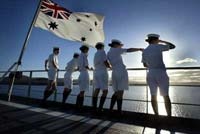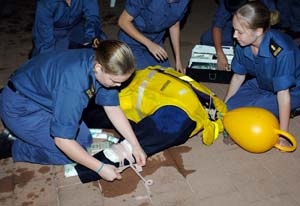Cadets FAQ
What do Cadets do?

Adventure and fun are the key ingredients for all camping, water sport and team challenge activities.
Australian Navy Cadets have great opportunities to:
- have fun
- make new friends
- be part of a team
- experience exciting and adventurous challenges
- learn to take responsibility
- develop their potential as leaders
- take part in physical activities.
Navy Cadets learn seamanship skills such as navigation, sailing, practical boat work, communications and signals and marine engineering. They are also taught a range of other skills including:
- leadership and team building skills
- firearms safety and marksmanship
- computer skills
- first aid
- cooking
- citizenship
- drill and ceremonial
- band activities (only those Training Ships that have a band)
Just add water for fun, adventure and friendship. Navy Cadets have oceans of it!

Can anyone join the ANC?
To be a Navy Cadet, you need to:
- be a resident of Australia
- be at least 12 years and 6 months old and under 19 years
- produce a statement from your family or doctor as to your ability to participate in Cadet activities
- not be a member of any other Cadet Corps or the Australian Defence Force.
What is the maximum age you can join?
Anyone over 12 years and 6-months old may become a Navy Cadet until they reach 19-years old. Once a person reaches that age they can no longer be a Cadet, however they may apply to be an ANC Officer or Instructor.
Will I have a uniform?
Navy Cadets are supplied uniforms free, on loan from the Navy. Uniforms include complete summer and winter ceremonial dress and working uniforms including items such as protective clothing and boating wear. These items must be returned if you leave the ANC.
Can I be promoted?
The ANC has a rank system similar to the Royal Australian Navy's.
All new Navy Cadets start as 'Recruits'. The general promotion pattern is: Seaman, Able Seaman, Leading Seaman, Petty Officer, Chief Petty Officer then Warrant Officer.
Once a cadet has reached the rank of Petty Officer, they may be considered for training to become a Cadet Midshipman.
Promotion to the next higher rank is by fulfilling a series of requirements through the course of training.
Are there any costs associated with being an Australian Navy Cadet?
Each Unit differs and some charge a joining fee, a per-quarter fee and a parade levy on training nights. Weekend activities, where meals are provided by the Unit, will normally incur a small cost per meal. Activities where meals are not provided are usually free of charge.
Also where training courses are conducted by outside agencies, such as the Australian Red Cross and the Australian Yachting Federation; costs are borne by parents. However, these fees are generally at a lower rate than is normally available. Week-long camps known as ACTs (Annual Continuous Training) also incur a fee.
For more information about activity fees contact your local ANC Unit.
How do I join?
Information about how to join Australian Navy Cadets is available here: www.navycadets.gov.au/how-to-join/
Are there opportunities for travel?
Yes, there may be opportunities to take part in Cadet activities such as annual camps that are held interstate. Also, there may be opportunities to take part in the international exchange scheme (fees apply) where selected Cadets travel to countries such as the UK, USA, Canada and many others.
Are Australian Navy Cadets in the Australian Defence Force?
No Navy Cadet is a member of the Australian Defence Force (ADF). Therefore, you will not be required to complete military service of any kind.
Will I be required to join the Navy or the ADF once I leave the ANC?
No, there is no obligation to join the Navy or any other part of the ADF once you leave the ANC. However, having had a taste of Navy life the ANC hopes that you may consider serving in uniform as a career.
What is a School-based unit?
A school unit is a Training Ship that has been established within a school. Other than that, there is no difference.


